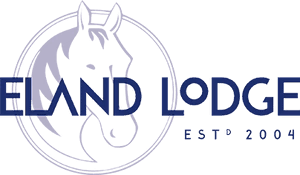Resident Wildlife at Eland Lodge: The Little Owl
So even though it is little, about the size of a large thrush, “Little Owl” is actually its “common name”, it’s Latin name is Athene Noctua and we have been lucky enough to be a grateful host to a family of Little Owls for the last 16 years. Surprisingly they are an immigrant, not popular these days, but unusually for introduced species they haven’t done terrible harm and have settled in rather well. The family we have on site have occupied a disused pump house for all of that time and It’s always been a little bonus when walking the dogs to look across and see one or if you’re very, very lucky two of them standing on the top of the door surveying their territory. The juveniles have quite indistinct markings kind of a “fluffy bunny” look, but the adults are quite the reverse, their markings are clear and precise with sharp striations and clear eyebrow markings that give them an almost comedic bad tempered look. It’s a look of permanent distain, like the look “that teacher” always gave, the disapproving Aunt, the girlfriends Dad, the Police Officer who knew you were guilty, he just didn’t know what for yet. But it’s just a look.
They are very neat, slightly longer in the leg than a lot of owls, pretty markings and a sharp well defined face, always a delight to see. Although roosting in the disused pump house, they hunt from the big Beech tree in our garden. During the day this tree is Jackdaw and Crow central with flocks of these Corvids enjoying the vantage the tree gives them to ride the wind and to spy any opportunity for food, but at night it belongs to the Owls. I hear their calls as they settle to hunt. It’s sort of a mewing call but when agitated it changes to a sharp yelping sound or a more urgent chi chi chi!
We have had Little Owls resident at Eland Lodge for all of the 16 years we have been here. The population never seems to vary, the same family in the same redundant building never diminishing or expanding always constant. They are not a prolific breeder, they raise only one clutch per year of 3-4 eggs and have a typical life span in the wild of three to four years which is not untypical for owls unfortunately. As they are not the most “busy” in the breeding stakes, they are obviously susceptible to changes in environment, feed and disease. Thankfully as we don’t use any pesticides, artificial fertilisers or weed killers the environment here is very stable and lacking in the poisons that have destroyed so many ecosystems. The stability this provides is an ideal environment for the owls to breed and maintain populations. As well as the lack of chemical inputs, we have taken some other more positive steps to help all of our bird populations, those domestic and those visiting seasonally. There are large tracks of uncultivated ground crossing the site allowing breeding environments for invertebrates and small mammals providing feeding opportunities for all of the birds on site. From small insects both flying and sedentary, larger invertebrates, beetles, harvestmen and the like, worms, field mice, voles etc these overgrown spaces provide a rich source of life, food and shelter and drive biodiversity.
The Little Owls feed off a mixture of invertebrates, beetles insects and the like, they will take small mammals such as field mice or voles but when you pull apart their owl pellets,(the regurgitated, indigestible parts of their food), it’s made up mostly of invertebrates. It never fails to surprise me how we exaggerate the size of they prey most hunters take, wolves are typically shown bringing down caribou or musk oxen but their diet is usually sustained by smaller prey like lemmings. And so it is with the Little Owl, whilst capable of catching mice and the like it’s normally more mundane fayre for our little friends. The owl pellets show that the bulk of the stuff they catch and eat are beetles and other large invertebrates.
Whilst on the subject of Owl Pellets, they are a fascinating thing in themselves. All owls produce them, they are the indigestible elements of their prey, normally bone, fur, insect carapaces they give a fascinating insight into the owl’s diet. The pellet is regurgitated,"sicked up” if you will, it has not gone all the way through the owl’s digestive system so they don’t smell, they are not slimy and are easy to handle. Owls normally regurgitate the pellets on a resting post or vantage point so they are quite easy to find and once found, you have a clear picture of what the bird had to eat over the last 48hrs. Don’t be squeamish put some gloves on if you have to and pull a few apart, you will be enthralled! The Barn Owl and Tawney Owl pellets are most fun, you can see the skulls and large limb bones of the small mammals they catch and devour, so their diet is obvious. Little Owl pellets are no less informative, you can see the masses of beetle and insect exoskeletons in them together with the occasional mammalian bit.
So there you have it, our favourite, constant, little friend who has occupied the site long before we came and will hopefully reside here long after we are gone. I love having them here they enrich us and the site and it is my fervent hope that they continue to prosper and enjoy their stay here. We will do everything we can to encourage and protect them.
